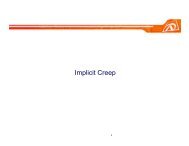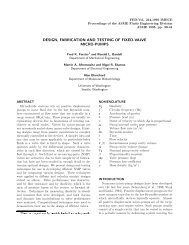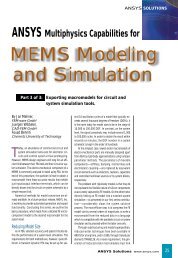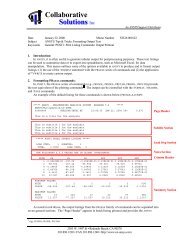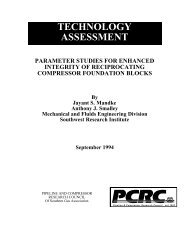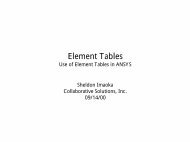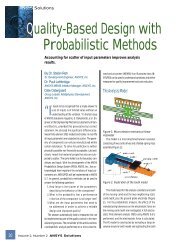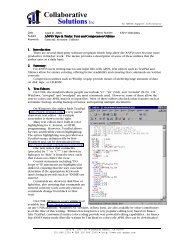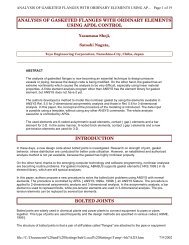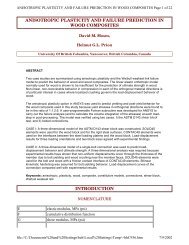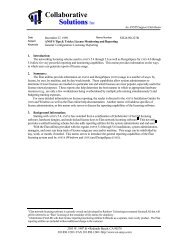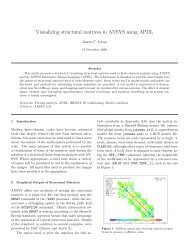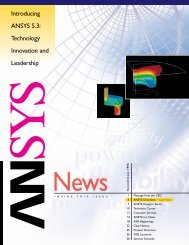Pyramid elements for maintaining tetrahedra to - ANSYS Users
Pyramid elements for maintaining tetrahedra to - ANSYS Users
Pyramid elements for maintaining tetrahedra to - ANSYS Users
You also want an ePaper? Increase the reach of your titles
YUMPU automatically turns print PDFs into web optimized ePapers that Google loves.
three swaps may be per<strong>for</strong>med until the <strong>to</strong>pology is sufficient <strong>for</strong> the<br />
merging of two <strong>tetrahedra</strong> <strong>to</strong> <strong>for</strong>m a pyramid. The necessary<br />
condition <strong>for</strong> this <strong>to</strong> occur is <strong>for</strong> the diagonal edge (edge A-B in<br />
Figure 4) <strong>to</strong> have exactly two adjacent <strong>tetrahedra</strong> or exactly three<br />
adjacent triangle faces.<br />
The order in which swaps are per<strong>for</strong>med may also affect the final<br />
quality of the pyramid and its neighboring <strong>tetrahedra</strong>. In order <strong>to</strong><br />
locally improve the quality of the <strong>elements</strong>, the order of swapping is<br />
dictated by the maximum potential element quality of the resulting<br />
<strong>elements</strong>. Figure 7 provides an example of how this is done.<br />
N4<br />
N 3<br />
N 2<br />
N5 A,B N N<br />
1<br />
5 A,B N1<br />
N 4<br />
N 3<br />
N5 A,B N N 1<br />
5 A,B N1<br />
N 4<br />
N 3<br />
(a) (b)<br />
N 3<br />
(c) (d)<br />
Figure 7 Local <strong>tetrahedra</strong>l trans<strong>for</strong>mations <strong>to</strong> define<br />
pyramid<br />
To simplify visualization, Figure 7(a) shows a “<strong>to</strong>p” view of the<br />
quadrilateral diagonal edge A-B (side view of the quadrilateral). The<br />
quadrilateral face in this case is defined by nodes A-N1-B-N5. There<br />
are initially four <strong>tetrahedra</strong> adjacent <strong>to</strong> edge A-B. The objective is <strong>to</strong><br />
reduce this number <strong>to</strong> two. The dotted lines in (b) show the three<br />
possible two-three swaps which can be per<strong>for</strong>med. To select<br />
potential two-three swap trans<strong>for</strong>mation pairs, each pair of <strong>tetrahedra</strong><br />
adjacent <strong>to</strong> a face sharing edge A-B is tested. A shape metric <strong>for</strong> each<br />
of the three potential <strong>tetrahedra</strong> <strong>to</strong> be <strong>for</strong>med as a result of a twothree<br />
swap is computed and summed. If a potential tetrahedron has a<br />
negative shape metric (the tetrahedron is inverted), the potential swap<br />
is immediately discarded as an option. The five-node set defined by<br />
nodes A-B-N2-N3-N4 in (b) shows a case where a negative shape<br />
metric would result if a two-three swap was per<strong>for</strong>med . The<br />
maximum value <strong>for</strong> the sum of the metrics <strong>for</strong> the potential <strong>tetrahedra</strong><br />
is used <strong>to</strong> indicate which trans<strong>for</strong>mation will be per<strong>for</strong>med. In this<br />
case, the <strong>tetrahedra</strong> A-B-N1-N2 and A-N2-B-N3 were trans<strong>for</strong>med in<strong>to</strong><br />
A-N3-B-N2, B-N3-N1-N2 and N1-N3-A-N2. As a result of the swap,<br />
only one of the three resulting <strong>tetrahedra</strong> is now adjacent <strong>to</strong> edge A-<br />
B, reducing the <strong>to</strong>tal number of <strong>tetrahedra</strong> adjacent <strong>to</strong> edge A-B by<br />
one (shown in (c)). This process is once again per<strong>for</strong>med. Figure 7<br />
(c) shows two potential trans<strong>for</strong>mations which could be per<strong>for</strong>med.<br />
The two-three swap resulting in the highest quality <strong>elements</strong> is<br />
effected resulting in the configuration in (d). At this point, the<br />
necessary conditions <strong>for</strong> the <strong>for</strong>mation of a pyramid are satisfied. The<br />
N 2<br />
two <strong>tetrahedra</strong> A-B-N1-N3 and A-N5-B-N3 are merged <strong>to</strong> <strong>for</strong>m the<br />
pyramid A-N1-B-N5-N3.<br />
It should be noted that geometric configurations of <strong>tetrahedra</strong><br />
adjacent <strong>to</strong> edge A-B may not allow any two-three swaps <strong>to</strong> occur.<br />
This occurs when all potential trans<strong>for</strong>mations result in at least one<br />
inverted tetrahedron. To avoid such a case, while infrequent, the<br />
pyramid open method is reverted <strong>to</strong> when geometric conditions do not<br />
allow local trans<strong>for</strong>mations.<br />
The shape metric, Q, used <strong>to</strong> determine the order of<br />
trans<strong>for</strong>mations, is the inscribed <strong>to</strong> circumscribed sphere ratio of the<br />
tetrahedron,<br />
Q<br />
r<br />
= 3<br />
R<br />
where r is the inscribed sphere radius and R is the circumscribed<br />
sphere radius. Joe (1995) presents a closed <strong>for</strong>m expression of the<br />
metric in terms of the tetrahedron’s node locations. This measure<br />
provides a maximum value of 1.0 <strong>for</strong> a regular tetrahedron. If the<br />
volume of the tetrahedron is less than zero, (the element is inverted),<br />
the metric is modified <strong>to</strong> return a negative value.<br />
Figure 8 shows the results of <strong>for</strong>ming pyramids from <strong>tetrahedra</strong>l<br />
trans<strong>for</strong>mations. Of the 25 pyramids <strong>for</strong>med in this example, two<br />
conditions existed in which local trans<strong>for</strong>mations could not be used.<br />
As a result, the pyramid open method was au<strong>to</strong>matically invoked.<br />
Table 1 displays minimum and average shape metrics <strong>for</strong> pyramids<br />
and <strong>tetrahedra</strong> <strong>for</strong> the model shown in Figure 8.<br />
Figure 8. Exploded view of pyramids <strong>for</strong>med using<br />
<strong>tetrahedra</strong>l trans<strong>for</strong>mations. Hexahedra (not shown)<br />
adjacent <strong>to</strong> quad faces.<br />
CLEAN UP<br />
While the methods presented do not allow the <strong>for</strong>mation of<br />
inverted <strong>elements</strong>, the quality of the pyramids and <strong>tetrahedra</strong> may be<br />
lacking. In order <strong>to</strong> improve local quality of <strong>elements</strong> in the<br />
transition region after trans<strong>for</strong>mations have been per<strong>for</strong>med, both<br />
smoothing and <strong>to</strong>pological cleanup is done.<br />
Smoothing<br />
Constrained Laplacian smoothing is done locally within the<br />
transition region. To accomplish this, a local search is done



